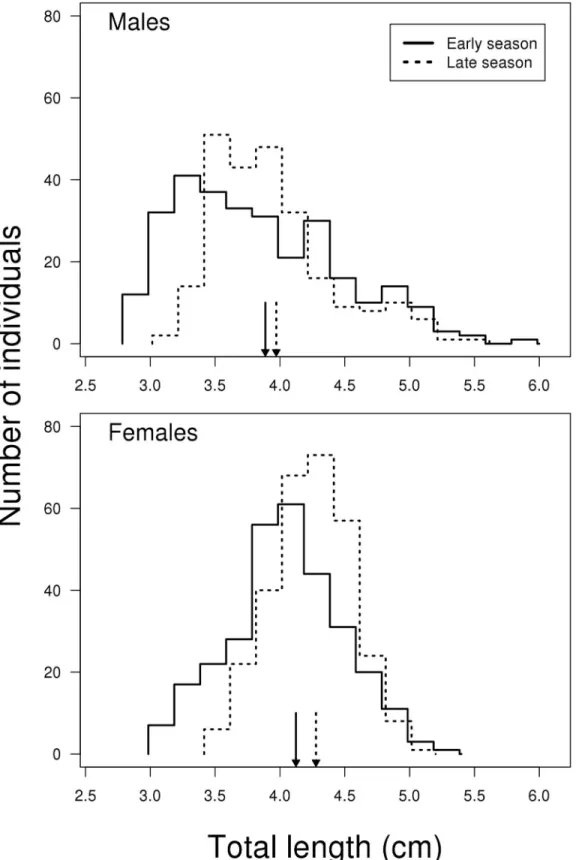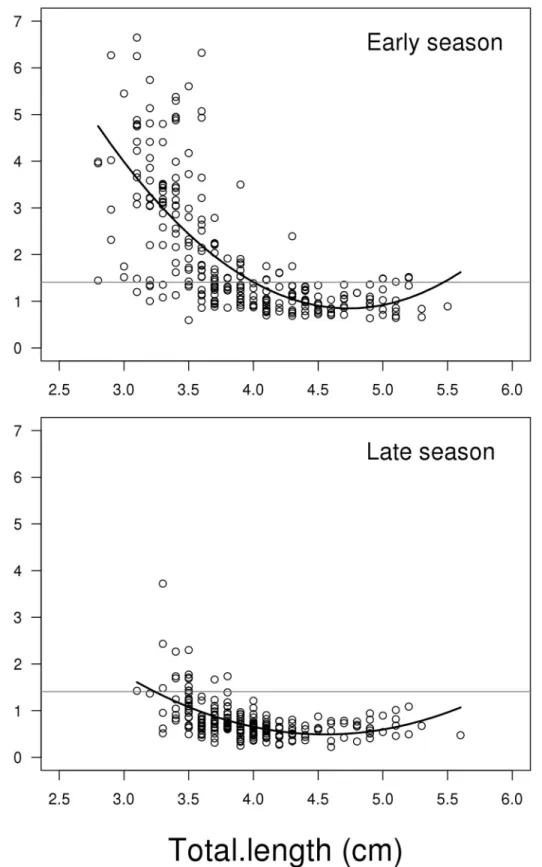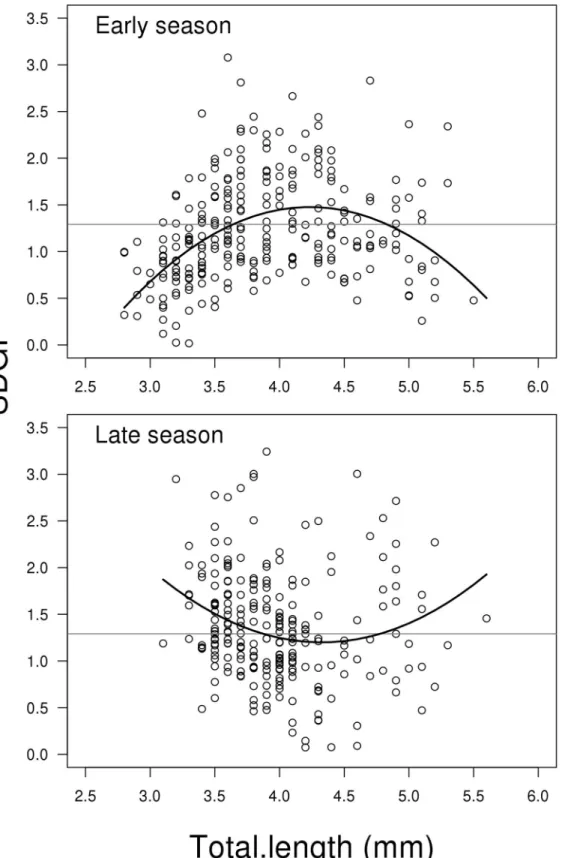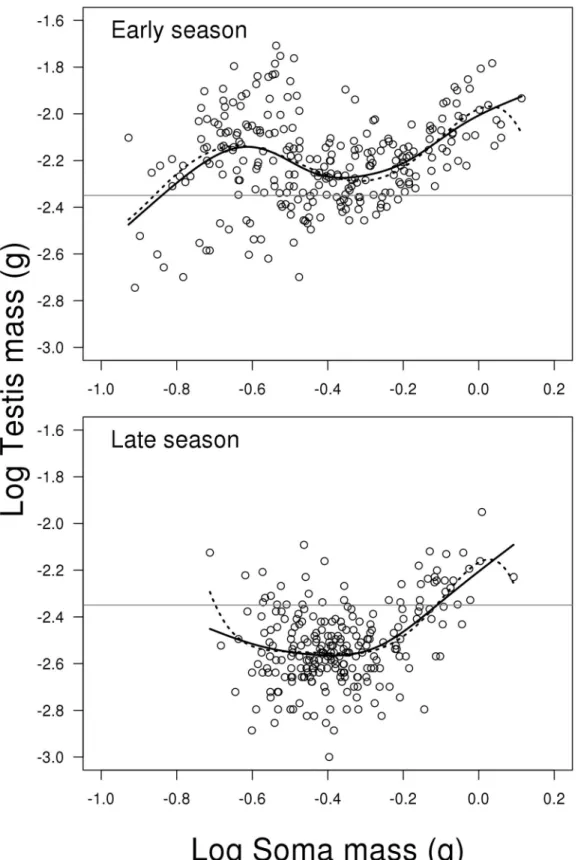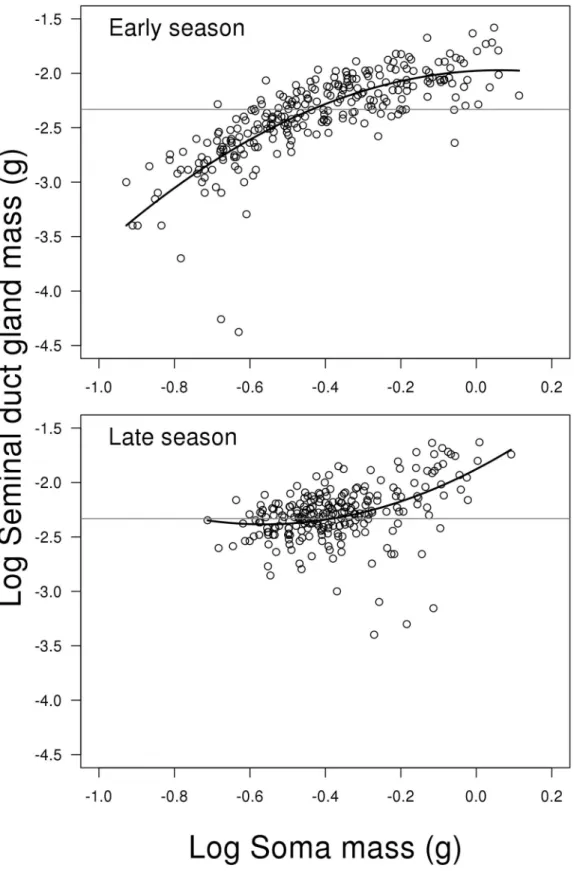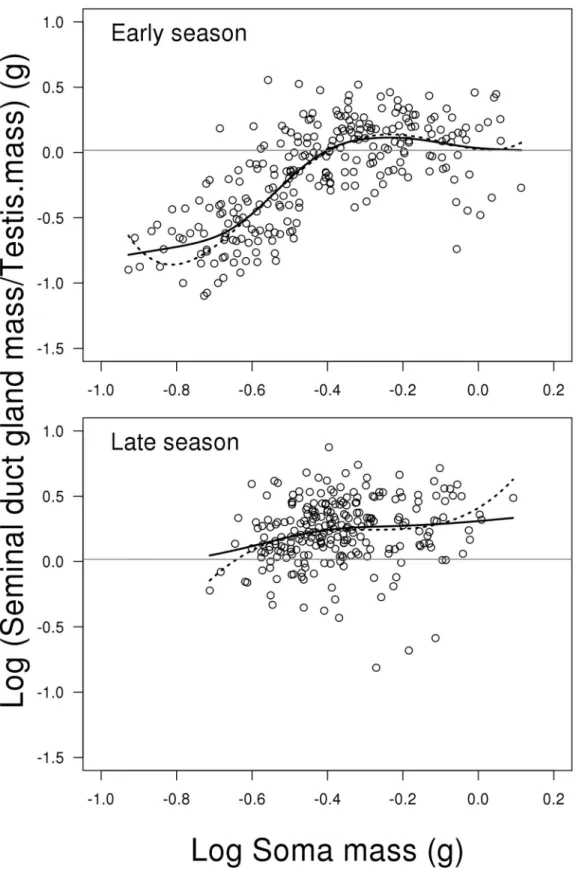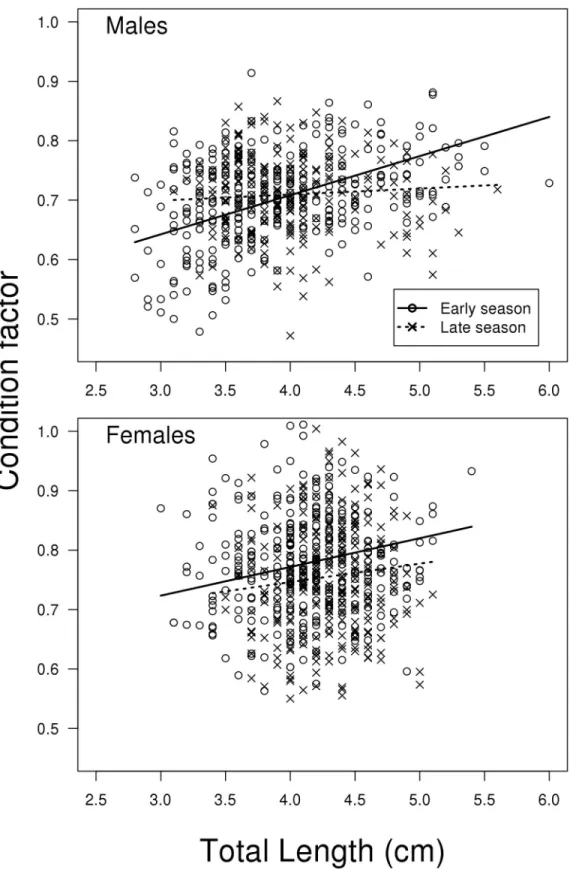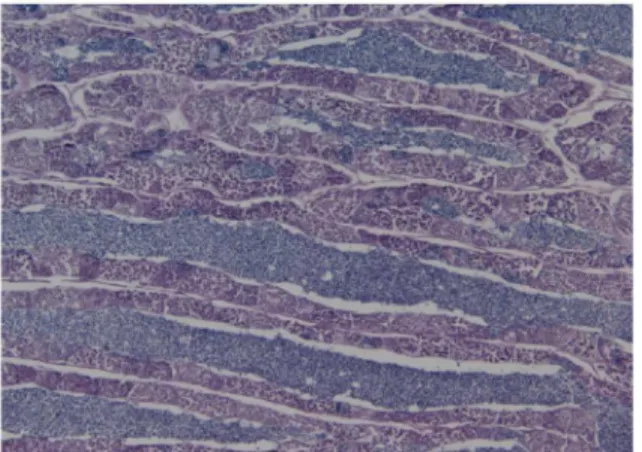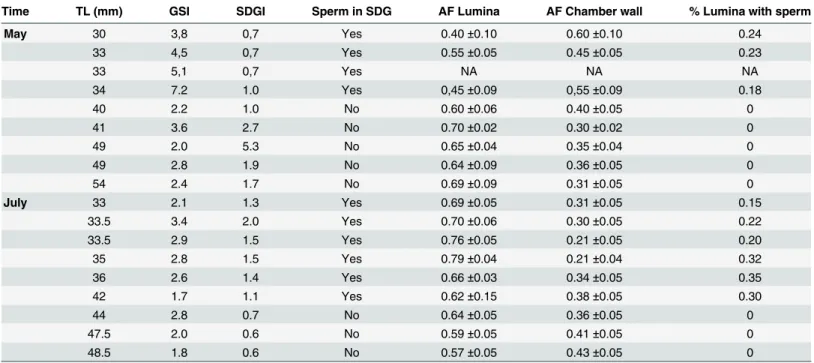Size Dependent Male Reproductive Tactic in
the Two-Spotted Goby (
Gobiusculus
flavescens
)
A. C. Utne-Palm1☯
*, K. Eduard2,4☯
, K. H. Jensen2‡, I. Mayer3‡, P. J. Jakobsen2‡
1Institute of Marine Research, Bergen, Norway,2Department of Biology, University of Bergen, Bergen, Norway,3Norwegian University of Life Sciences, Oslo, Norway,4Oslo University Hospital, Oslo, Norway
☯These authors contributed equally to this work.
‡These authors also contributed equally to this work. *annecu@imr.no
Abstract
Male investment in testes and sperm duct gland in the polygamous nest breeding two-spot-ted gobyGobiusculus flavescens(Fabricius) was investigated in relation to time in repro-ductive season and individual physical parameters. This small teleost fish is most likely the most abundant species found along the rocky shores of the North East Atlantic. The two-spotted goby has a single reproductive season, during which nest-caring males can raise several clutches of offspring. According to the literature the males are on average larger than the females. Here we report for the first time a population showing a reversal of this trend, with males on average being smaller than females, a difference likely caused by a large proportion of small males. Early in the breeding season these small males have typical sneaker characters, with relatively large testes and small seminal duct glands compared to the larger dominant territorial males. The presence of these two alternative male reproduc-tive tactics is confirmed by histological studies, which shows the presence of sperm in the sperm duct glands (SDG) of smaller males, but not in the SDG of intermediate and larger males. To our knowledge, males with typical sneaker characters have not been reported in earlier studied populations of two-spotted goby. Interestingly we found that testes invest-ment declined significantly over the course of the breeding season, and that this reduction was significantly more pronounced in small compared to the large males. Further, a signifi-cant increase in seminal duct gland (SDG) mass was observed for the smaller males over the breeding season. We propose that this indicates a possible shift in mating tactic by smaller males from a parasitic to a nest-holding tactic over the course of the breeding sea-son. Thus, the observed size dependent plasticity in investment in SDG over time suggests that the reproductive tactic ofG.flavescensis conditional, and possibly influenced by mate availability and male—male competition.
a11111
OPEN ACCESS
Citation:Utne-Palm AC, Eduard K, Jensen KH, Mayer I, Jakobsen PJ (2015) Size Dependent Male Reproductive Tactic in the Two-Spotted Goby (Gobiusculus flavescens). PLoS ONE 10(12): e0143487. doi:10.1371/journal.pone.0143487
Editor:Lorenzo Zane, University of Padova, ITALY
Received:December 29, 2014
Accepted:November 5, 2015
Published:December 7, 2015
Copyright:© 2015 Utne-Palm et al. This is an open access article distributed under the terms of the Creative Commons Attribution License, which permits unrestricted use, distribution, and reproduction in any medium, provided the original author and source are credited.
Data Availability Statement:The data are all contained within the paper and its Supporting Information files.
Funding:This study was funded by the University of Bergen through the contributing work of a Master student.
Introduction
Competition for mating partners may lead to alternative mating strategies and tactics [1]. In teleost fishes in particular, this is often manifested in the occurrence of two viable alternative male reproductive strategies. The larger dominant males strive to monopolise mates by a com-bination of elevated aggressive behaviour and an increased investment in secondary sexual traits (nuptial colouration, ornaments and chemical signals), and/or by monopolising
resources important to the female. Alternatively, the generally smaller males compete with the dominant males by adopting a parasitic tactic, either by sneaking behaviour or female mimicry, where individuals avoid making such investments and instead, exploit the reproductive invest-ment of others. By saving costs related to the developinvest-ment of secondary sexual traits, mate attraction and intra-sexual contests, parasitic spawners (sneakers) can alternatively invest more in sperm production [2–4]. However, only in a few cases is the choice of male reproduc-tive tactic fixed for life, and in most cases it is plastic, being conditional on the prevailing condi-tions which will determine which of the alternative male reproductive strategies will increase fitness most [5]. The decision on which mating tactic to adopt is usually correlated to body size [5], and commonly an ontogenetic transition from a parasitic to a dominant tactic occurs through life as the male grows [4,6]. The tactic switch point should be sensitive to both eco-logical and demographic events—as they both can affect the fitness of a given tactic [5]. In spe-cies where males are using conditional reproductive strategies such as physical condition, status (relative size), population density [7] or sex ratio [6,8,9,10,11], all these factors have been found to influence the male’s choice of tactic.
In common with most teleost fishes displaying alternative mating tactics, a conditional tac-tic seems to be most common in species of the family Gobidae. In gobies, larger males usually adopt the dominant mating tactic (territorial nest holders), while the smaller males adopt the parasitic tactic (sneakers) [12–14]. Even more drastically, some gobies change their sex and hence their reproductive tactic completely [15].
In the Bergen area (south-west Norway) the two-spotted gobyGobiusculus flavescens (Fabri-cius) are born in May to August, they spawn the following season and die during fall after their one and only spawning season (become ca 1.5 years old) [16]. However, during this single reproductive season males can mate—and care for several clutches of offspring [17]. The males are known to adopt a nest in indentations on rocky surfaces, in empty mussel shells or in the hold fast of kelp, from where they attract females. According to earlier studies in Ireland [18], Scotland [17],and Sweden [19] the two-spotted goby exhibits sexual size dimorphism, where males are on average larger than females. However, in the presented studied population on the west Norwegian coast (Bergen) this size dimorphism is reversed as average female size is slightly larger than average male size, caused by a large proportion of very small males (Fig 1). Our prediction was that these small males might act as parasitic spawners (sneakers).
A study from the west coast of Sweden, [19] (where we find the traditionally reported size dimorphism♂>♀) previously showed that over the short breeding season of the two-spotted
goby there was a transition from a strong male–male competition with intensive courting males in the beginning of the season to a strong female–female competition with actively court-ing females towards the end of the season. This observation has recently been supported by fur-ther studies in the same location (Gullmarsfjorden, west coast of Sweden), reporting that i) the size of nest holding males decreased over the season—indicating a decrease in male—male competition [20], and ii) courtship is typically initiated by males and terminated by females early in the season, while the opposite pattern is found late in the season [21].
Fig 1. Size distribution of male and female two-spotted goby in early (May) and late (July) reproductive season.To make it easier to distinguish between the lines in cases where they overlap, the lines for early and late season are placed 0.015 units to the left and right on the x-axis, respectively. Average lengths related to season are marked with arrows. Sample size females N = 600, males N = 533.
season. Thus one should expect to find smaller males using a sneaking strategy, especially early in the breeding season when male—male competition is at its highest.
Nest holding male gobies are known to lay mucous ejaculates, defined as sperm trails, which slowly dilute into the water and release active sperm for several hours, reaching eggs via the surrounding water [23,24]. The mucins of the ejaculate are produced by a pair of accessory sperm duct glands (SDGs), whose secretory activity have been found to vary in gobioid species where males perform alternative mating tactics [24,25]. Large dominant males, which build nests and perform parental care, exhibit larger SDGs and more abundant secretions than males using a parasitic tactic [24,25]. Further, it has been reported that parasitic spawners, and not dominant males, use their SDGs for sperm storage [25]. Thus, the presence and the relative development and use of SDGs represent an excellent proxy to evaluate the presence of alterna-tive male mating tactics.
The present study was undertaken to determine firstly, whether the small males discovered in the Bergen population display a parasitic spawning tactic. Secondly, if so we wanted to deter-mine whether the prevalence of this spawning tactic changes over the course of the breeding season.
Given the difficulty in finding nests in the field, and that small males are rarely observed (<5% of all males observed when snorkelling were small males), our conclusions are based on
physiological and histological findings from fish sampled by beach seining. Histological evalua-tion of SDG morphology should underpin the findings of a sneaking tactic among the smaller males, by revealing low mucin production and presence of sperm in the SDGs. As such, our conclusions will be made from SDG histology together with data on testes and SDG invest-ment—across season and location. In earlier studies the flexibility in male tactics of a species has been demonstrated experimentally by manipulating the level of male-male competition or female availability i.e. [9,12,14,26,27]. Here we demonstrate seasonal plasticity in a natural un-manipulated population.
Methods
Studied species
The two-spotted goby is small ubiquitous marine fish (3–5 cm), which inhabits the sub-tidal area along rocky shores in the North East Atlantic (from Gibraltar to Northern Norway). The two-spotted goby is probably the most numerous littoral fish species found along rocky shores of North East Atlantic, where it reaches average densities of 70–165 individuals m-3[16]. Dur-ing the breedDur-ing season males occupy and defend nest sites, commonly located in the holdfast or blades of kelp (Laminariaspp.), indentations on rocky surfaces or empty mussel shells [28]. They have a single spawning season (in the present study area from May to August) during which both males and females spawn several times. Males of two-spotted gobies display pro-nounced parental care, with nest holding males guarding, fanning and cleaning the eggs until hatching [22]. A nest holding male continues to attract females throughout the season and can have eggs from several females at the time [17,22,29].
Fish sampling and handling of samples
our sampling area, after which the enclosed area was sampled twice with a second beach seine, before finally the outer seine was hauled in.
Three different sampling locations on the west coast of Norway were selected in order to obtain samples as representative as possible of the habitat of the two-spotted goby. These loca-tions were the inner and outer Fanafjord and the Kvalen Raunefjord, all located north of Ber-gen, which differed in terms of exposure, temperature and salinity. Fish used in the histological studies where captured by beach seine in May and July 2008 at the Kvalen Raunefjord location. To avoid stress and injury during capture the beach seine was pulled in slowly, and the fish were gently collected by dip net and placed into shaded buckets containing 20 litres of fresh seawater as well as some fresh kelp for shelter. From the seine samples, a random and represen-tative subsample of 100 females and 100 males was taken (or less than 100 if less fish were caught in the beach seine), after which the remaining fish, as well as non-target species, were carefully returned to the sea. Females and males are easy to distinguish by eye due to distinct ornamentation during the reproductive season (males has iridescent blue spots and females has orange bellies) [19]. The small males also display these ornamental colours. Identification of sexes during the breeding season was determined by the marked differences in colour pat-terns and nuptial colouration between the sexes [28]. The sub-samples of gobies were quickly transported back to the aquaria facility at Espegrend field station, University of Bergen, where they were transferred to two 100 litre tanks in a temperature control room. The tanks were sup-plied with artificial kelp shelter and through-flowing aerated natural seawater kept under ambi-ent photoperiod and the same temperature (13–18°C) as in the field. Later, on the same day of capture, all fish (one by one) were netted out with a dip net to be sacrificed by an overdose of MS222 (3-aminobenzoic acid ethyl ester). Each fish was individually weighed (± 0.1 mg) and measured (total length; ± 1.0 mm), after which the fish was dissected to confirm sex. For males, the paired testes and SDGs were carefully separated and weighed individually in order to calcu-late the gonadosomatic index (GSI = testes weight + SGD weight/body weight x 100) and semi-nal gland duct index (SGDI = SGD weight/body weight x 100). The GSI was also calculated for females. In addition, the soma body mass (body weight—gonad weight) and condition factor (CF = body weight (g) x 100/body length (cm)3were calculated for both sexes. Only data of the male gonads are presented here.
Histology
For gonad histology studies a size representative group of males (N = 18) were sampled from the May and the July seine catches. Fish were caught and handled as described above. Follow-ing dissection, testes and SDGs were excised, weighed separately (±0.1 mg), and fixed in Die-trich’s solution (900 ml distilled water, 450 ml 95% ethanol, 150 ml 40% formaldehyde, 30 ml acetic acid) for 4–5 months before being embedded in paraplast. Seminal vesicles and gonads were sectioned transversally (6μm) and mounted on slides for histological examination.
Statistics
All statistics and plots were performed using R version 3.2.2 (R Development Core Team 2015,
http://www.r-project.org). Fish size was compared between sex and season by using a linear
mixed effects model (LME) with the predictor total length of the fish (cm) and the two categor-ical predictors season and sex. Station was set as a random effect factor. Sample sizes for males and females were 533 and 600, respectively. Demography was investigated by making simple frequency plots of fish lengths depending on sex and season. Additionally, for each sex we made size-frequency distributions over early and late season for the 25% smallest and largest fish, respectively. This allowed us to get a clearer picture of eventual demographic differences between males and females over the season.
For male fish, the investment in seminal duct gland (SDG) and testes were compared between early and late season, i.e, May vs July. We did this by using five different models to cover the most commonly used methods from earlier studies e.g. [24,33].
Model A,GSI: The response variable was the gonadosomatic index (GSI) and the two pre-dictors were total length and season.
Model B,SDGI: The response variable was the seminal duct gland index (SDGI) and the two predictors were total length and season.
Model C,Testis mass: The response variable was log (testis weight) and the predictors were log(soma mass) and season.
Model D,SDG: The response variable was log (seminal duct gland weight) and the two pre-dictors were log (soma mass) and season.
Model E,relative investment in SDG: The response variable was log (seminal duct gland weight/testes weight) and the two predictors were log (soma mass) and season.
Since the five models above consist of a continuous response variable and two predictors where one is continuous and one is categorical, it is natural to think about an ANCOVA where the two regression lines for early and late season are compared. However, to account for an eventual curvature in the data we used polynomial modeling for the continuous predictor of each model. Log likelihood ratio tests (LRT) were used for determining the number of curva-ture parameters (polynomial order) for the continuous predictor. Since the data were collected over three different stations, we needed to account for the random effect of stations. We did this by using linear mixed effects models LME [34,35]. Since LMEs with two predictors and a polynomial term gives a rather complex set of outputs, we only list the most important results for each of the five models and give the full list of output in the supporting information mate-rial (S1 File). In cases where the number of curvature parameters determined from the LRT gave polynomial models with an order higher than three, we replaced the model with a general-ized additive model (GAM). We did this since the biological interpretation of parameter esti-mates becomes extremely difficult for such high order polynomial models.
In the models about SDG and testes investment the sample size was reduced from 533 to 506 as we were lacking SDG and testes measurements for 27 of the fish (due to problems sepa-rating the testes and SDG during dissection).
Condition factor was analysed for females and males in one model, allowing for a three way interaction between the predictors; total length of the fish, season and sex. We used an LME for this purpose and the random effect factor was the same as explained in the models above.
Based on histological findings on whether the SDGs contained sperm or not we divided the males into either“sneakers”(size range with sperm in SDG) and“territorial”males (size range without sperm in SDG) for early and late season. Finally, we performed a linear regression (log (Y) = log (a) + blog (X), where Y refers to SDG and Testes weight and X to soma weight), to look at
Ethics
All aspects of this study, including field sampling, fish transportation, and killing of fish (by overdose of MS222), were approved in advance by the Animal Care Committee at the Univer-sity of Bergen. This committee closely follows the strict regulations of the European Commis-sion directive for animal used for scientific purposes. Collection of fish along the Norwegian coast does not require permission. The field collections did not involve endangered or pro-tected species.
Results
Demographic findings
The comparison of fish size depending on sex and season revealed no interaction between the two predictors, i.e. the change in size when going from early to late season is the same for the two sexes (LME; F1, 1127= 1.385, P = 0.240). However, there was a significant effect of both sex
and season, where the mean size of males is significantly smaller than females (LME; F1, 1127=
98.185, P<0.001,Fig 1) and mean size is significantly smaller in the early compared to the late
breeding season (LME; F1, 1127= 22.087, P<0.001,Fig 1). Among all male fish sampled in this
study, the ones belonging to the size range representing the 25% smallest males are more repre-sented in the early compared to the late breeding season, with 100 and 33 small males sampled in the early and late breeding season, respectively. The same trend was also observed for the 25% largest males with 82 and 51 large males in the early and late breeding season, respectively. For females, the 25% smallest individuals were represented with 92 and 58 females sampled in the early and late breeding season, respectively, while the 25% largest females, were represented with 66 and 84 females sampled in the early and late breeding season, respectively. Thus, our results indicate a higher mortality or a different growth rate among larger males compared to females in the late breeding season.
Gonadosomatic index (GSI)
The model for GSI showed a significant interaction between the two predictors Total length (including second order polynomial) and Season (LME; F2,498= 21.763, P<0.001,Fig 2). This
indicates that the relationship between GSI and fish length changes from early to late in the breeding season.Fig 2shows that this is mainly due to the high proportion of small fish having high GSI values in the early compared to the late breeding season. This is supported by the treatment contrasts from the model (the summary output of R): Early season has significantly higher mean than late season (contrast between mean of early and late season; t498= 14.256,
P<0.001), and the relative decrease in GSI depending on total length is steeper in early
com-pared to late season (contrasts between first order polynomials of early vs late season; t498=
6.483, p<0.001). The untransformed mean GSI in early and late season is 1.981 (SE = 0.084)
and 0.778 (SE = 0.026), respectively. For a complete list of results from the model see Support-ing information material (Model A inS1 File).
Seminal duct gland index (SDGI)
The model for SDGI showed a significant interaction between the two predictors Total length (including second order polynomial) and Season (LME; F2,498= 24.493, P<0.001,Fig 3),
Fig 2. Scatterplots showing gonadosomatic index GSI (GSI = (testes weight + SDG weight) / body weight*100) related to total length for early and late reproductive season.The solid lines represent the mixed effect model. The grey horizontal lines represent the average of the full dataset—independent of season and soma mass. Early season has significant higher mean than late season and the relative decrease in GSI depending on total length is steeper in early compared to late season (for more details seeresults). N = 506.
Fig 3. Scatterplots showing seminal duct gland index SDGI (SDGI = (SDG weight) / body weight*100) related to total length for early and late reproductive season.The solid lines represent the mixed effect model. The grey horizontal lines represent the average of the full dataset—independent of season and soma mass. Change in SDGI depending on fish length is different between early and late season. This is mainly due to opposite curvatures between early and late season data (for more details seeresults). N = 506.
curvature is the reverse. This difference in curvature is significant (contrast between second order polynomials of early vs late season; t498= 6.434, P<0.001,Fig 3). The mean SDGI-level
in the early season is slightly lower than in the late season (t498= 2.613, P = 0.009,Fig 3). For a
complete list of results from the model see Supporting information material (Model B inS1
File).
Testis weight
The model for log testis weight showed a significant interaction between the two predictors log soma mass (including fifth order polynomial) and season (LME; F2,492= 3.048, P<0.010,Fig 4). This means that the change in testis weight depending on fish body mass is different between early and late season. Due to the high order polynomials, we replaced the model with a GAM, as shown in Supporting information material (Model C inS1 File). This model con-firms that the effect of body mass depends on season, where there are more curvatures in early season (GAM; edf = 4.912, Ref. df. = 6.055, F = 9.741, P<0.001,Fig 4), compared to late season
(GAM; edf = 2.838, Ref. df. = 3.669, F = 9.433, P<0.001,Fig 4). However, the most
pro-nounced difference been early and late season is that the general level of investment is higher early compared to late in the season (GAM; contrast between mean of early and late season; t = 17.150, P<0.001,Fig 4). The untransformed mean weight of testes in early and late season
is 6.987 mg (SE = 0.195) and 3.302 mg (SE = 0.093), respectively. For a more complete list of results from the models see Supporting information material (Model C inS1 File).
Seminal duct gland
The model for SDG investment reveals a significant interaction between the two predictors log soma mass (including second order polynomial) and season (LME; F2,498= 20.625, P<0.001,
Fig 5). This means that the change in SDG investment depending on fish soma mass is different
between early and late season.Fig 5and the summary output from R shows that this is mainly due to a stronger positive relationship between relative investment in SDG and soma body mass in the early compared to late season (contrast of first order polynomials between early and late season; t498= 5.540, P<0.001). The untransformed mean weight of seminal duct
gland in early vs. late season is 5.711 mg (SE = 0.256) and 6.145 mg (SE = 0.250), respectively. For a complete list of results from the model see Supporting information material (Model D in
S1 File).
Relative investment in seminal duct gland
The model for relative investment in SDG, i.e. log (SDG weight/ testis weight), showed a signif-icant interaction between the two predictors log soma mass (including fourth order polyno-mial) and season (LME; F2,494= 9.989, P<0.001,Fig 6). This means that the change in testis
weight depending on fish body mass is different between early and late season. Due to the high order polynomials, we replaced the model with a GAM, as shown in Supporting information material (Model E inS1 File). This model confirms that the effect of body mass depends on sea-son, where the curvature in early season is highly significant (GAM; edf = 3.999, Ref. df. = 5.008, F = 5.600, P = 0.001,Fig 6), while it is non-significant in the late season (GAM; edf = 0.667, Ref. df. = 0.667, F = 0.515, P = 0.558,Fig 6). This difference in curvature is seen
fromFig 6, where the early season shows an increase in investment over increasing fish body
mass that levels off for the biggest fish, while the increase over body mass is weaker in the late season (Fig 6). Further, the level of investment is lower early compared to late in the season (contrast between mean of early and late season; t = 12.200, P<0.001,Fig 6). For a more
Fig 4. Scatterplots of log testes weight on log soma mass depending on reproductive season.The solid lines represent the generalized additive model, while the dotted lines represent the mixed effect model. The grey horizontal lines represent the average of the full dataset—independent of season and soma mass. The decline in testes weight for small fish when going from the early to late breeding season is more pronounced than for the large fish (see resultsfor further details). N = 506.
Fig 5. Scatterplots of log seminal duct gland mass on log soma mass depending on reproductive season.The solid lines represent the mixed effect model. The grey horizontal lines represent the average of the full dataset—independent of season and soma mass. Change in SDG investment depending on fish soma mass is different between early and late season. This is mainly due to a stronger positive relationship between relative investment in SDG and soma body mass in the early compared to late season (seeresultsfor further details). N = 506.
Fig 6. Scatterplots of log relative investment in seminal duct gland to testes weight on log soma mass depending on reproductive season.The solid lines represent the generalized additive model and the dotted lines represent the mixed effect model. The grey horizontal lines represent the average of the full dataset—independent of season and soma mass. Change in relative SDG investment depending on fish soma mass is different between early and late season. This is mainly due to a stronger positive relationship between relative investment in SDG and soma body mass in the early compared to late season. Further, relative SDG investment is lowest early season due to a low investment of fish with low soma mass (seeresultsfor further details). N = 506.
Condition factor related to size, season and sex
The model for condition factor showed a strong tendency of a three-way interaction between season, size and sex (LME; F1,1123= 3.742, P = 0.053,Fig 7). Thus, the change in slope
depend-ing on season is different between males and females. This is also seen inFig 7where the posi-tive relationship between fish size and condition factor is clearly reduced when going from early to late season for the males but not for the females. The treatment contrasts of the model shows that the difference in slope of the two regression lines for females is not significant (t1123
= 1.079, P = 0.281,Fig 7), while it is significant for the males (same model but with relevelled treatment contrasts for sex; t498= 4.712, P<0.001,Fig 7). For a complete list of results from
the model see Supporting information material (Model F inS1 File).
Histology
–
presence of sperm in SDG related to size and season
All the 18 males whose reproductive organs were histologically examined were mature and had paired testes. The sperm transport system consisted of two main sperm ducts which fuse into a single common sperm duct, from which outgrow a pair of wing-like accessory structures (SDG) before reaching the urogenital opening. The testes are organized in lobules, of the unre-stricted spermatogonial type [38,39], whose walls were lined with germinal epithelium, pre-senting all the different stages of spermatogenesis, and lumina full of sperm in ripe males (Fig 8a). The SDGs are multi-chambered, as commonly observed in gobioid species [40]. The chamber wall consists of an internal single layer of epithelial cells, a basal lamina and an exter-nal thin layer of connective tissue (Fig 8a). The SDG’s chamber lumina were more or less full of a mucin-like substance, which reacted positively to staining for sialoglycoproteines (Fig 8, PAS a and c), and in some cases large amounts of sperm were also present in the lumina (Fig 8d). The quantities of mucin and sperm in the SDG differed in relation to size (TL). At the beginning of the breeding season in May, the four smallest males (30–34 mm TL) had small SDGs with a smaller lumina (0.40–0.56%) to chamber wall (0.60–0.44%) fraction of which 18–
24% contained sperm (Table 1andFig 4d). In contrast, the eight intermediate and larger males caught in May had larger SDGs with large mucin-rich chambers containing no sperm
(Table 1). Towards the end of the breeding season in July, all males had relatively large SDGs
(seeFig 5) rich in mucin—giving a lumina fraction of 0.62–0.79. In the late breeding season
smaller and medium sized males had sperm within 15–35% of the mucin-rich lumina cham-bers (Table 1). When grouping males into sneakers and territorial males based on histological findings (Table 1), we found that sneaker male’s invested more (higher“b”value,Table 2) in testes than in SDG early in the season, while the opposite was the case for territorial males. No such difference was found in late season, when all males invested most in SDG (Table 2).
Discussion
Here we report for the first time a population of two-spotted gobies in which males have a smaller average size (40 mm) compared to females (43 mm). All previous studies on two-spot-ted gobies (populations in Sweden, Scotland and Ireland) have reportwo-spot-ted the opposite, with males being larger than females, and further none of these studies reported the occurrence of small sneaker males. For example, on the Swedish west coast, which is the most thoroughly studied population, the gobies exhibit sexual size dimorphism, with males on average slightly larger than females (average male and female size being 47–48 and 42–47 mm respectively; [41,
Fig 7. Condition factor.Total weight (g)*100/total length (cm)3) vs. length, for males sampled early and late in the reproductive season. N = 533.
acid-fish populations of one species as it does between related species. Fishes plasticity in body size, together with intersexual competition that is affected by environmental variations, such as availability of nest sites or size related mortality is suggested explanations to the great variation in SSD among fish [43,44].
As predicted, early in the breeding period the smaller males displayed typical sneaker mor-phological characteristics, with relatively large testes and small SDG’s containing sperm. We found that (1) testes weight decreased in all males size categories from early to late in the breed-ing season, with this decrease bebreed-ing more pronounced in the smaller and intermediate males
(Fig 4). Accordingly, (2) the SDG weight increased significantly for smaller males from the
early to late breeding season, which was not the case for larger and intermediate sized males
(Fig 5). Further, (3) histological studies revealed the presence of sperm throughout large areas
of the SDGs in small males both early and late in the breeding season, whereas the SDGs of larger males contained no sperm at any time of season (Table 1,Fig 8). This temporal shift found in the smaller males, from small sperm-rich SDGs to larger mucin-rich SDGs (still con-taining sperm) occurred concomitant with an overall decrease in testes investment (relative investment in SDG/ testes,Fig 6andTable 2). This result basically implies a change in mating tactic among the smaller males. The sperm seen in the SDGs of small and intermediate sized
Sciff`s). Sperm duct gland of a 34 mm TL male goby, sampled in the early breeding season (D). Chambers are small poorly developed and many of them are filed with sperm and little or no secretion. Haematoxylin and eosin staining. x10. Pictures showing two males, caught in the early breeding season (May) with a total length of 53 and 33 mm, weight 0,840 and 0,120 g accordingly (E). Right picture shows same fish with dissected testes (yellow elongated) and SDG (transparent elongated). Testes and SDG weight of the 53 mm male were 0,0076 g and 0,0122 g, and for the 33 mm male 0,0100 and 0.0013 g accordingly (one of the SDG’s from the 33 mm male is missing on the picture).
doi:10.1371/journal.pone.0143487.g008
Table 1. Length, GSI and SDGI values and histological data for maleGobiusculus flavescenscollected in early (May) and late (July) reproduction season 2008.
Time TL (mm) GSI SDGI Sperm in SDG AF Lumina AF Chamber wall % Lumina with sperm
May 30 3,8 0,7 Yes 0.40±0.10 0.60±0.10 0.24
33 4,5 0,7 Yes 0.55±0.05 0.45±0.05 0.23
33 5,1 0,7 Yes NA NA NA
34 7.2 1.0 Yes 0,45±0.09 0,55±0.09 0.18
40 2.2 1.0 No 0.60±0.06 0.40±0.05 0
41 3.6 2.7 No 0.70±0.02 0.30±0.02 0
49 2.0 5.3 No 0.65±0.04 0.35±0.04 0
49 2.8 1.9 No 0.64±0.09 0.36±0.05 0
54 2.4 1.7 No 0.69±0.09 0.31±0.05 0
July 33 2.1 1.3 Yes 0.69±0.05 0.31±0.05 0.15
33.5 3.4 2.0 Yes 0.70±0.06 0.30±0.05 0.22
33.5 2.9 1.5 Yes 0.76±0.05 0.21±0.05 0.20
35 2.8 1.5 Yes 0.79±0.04 0.21±0.04 0.32
36 2.6 1.4 Yes 0.66±0.03 0.34±0.05 0.35
42 1.7 1.1 Yes 0.62±0.15 0.38±0.05 0.30
44 2.8 0.7 No 0.64±0.05 0.36±0.05 0
47.5 2.0 0.6 No 0.59±0.05 0.41±0.05 0
48.5 1.8 0.6 No 0.57±0.05 0.43±0.05 0
MaleGobiusculusflavescenscollected in May and July 2008 presenting total length (TL) in mm gonadosomatic index (GSI; gonad weight/somatic weight *100) sperm duct gland index (SDGI; SDG weight/somatic weight*100) and whether histological study revealed presence of sperm in SDG or not. Areal fraction (AF) consisting of lumina or chamber wall is given as well as relative number (proportion) of luminas containing sperm.
males in the late breeding season could be sperm left over from a time when the SDGs func-tioned primarily for sperm storage (an earlier sneaking period), or that the SDGs continue to be used as sperm storage as well as mucin producers. The grass goby,Zosterisessor ophiocepha-lus, has been found to have the continuum type of seminal vesicles, with a decreasing amount of sperm with increasing body length [13]. In common with the black goby,Gobius niger, the grass goby was found to have an intermediate size-range of males who invested in both SDGs and gonads, and where the seminal vesicles were used for both sperm storage and mucin pro-duction [25]. This type of intermediate male (males that invest in SDG and store sperm there as well) may be too small to gain a nest when competing with larger males but are sufficiently large to compete opportunistically for vacated territories. Therefore depending on opportunity, they may become nesting males or adopt a sneaking tactic for mating [25]. These findings sug-gest that a territorial reproductive tactic is too costly for small males during the early breeding season, or females would not choose smaller males when male-male competition is high, and for these reasons the smaller males displayed an alternative sneaking tactic. However, our results also show that these smaller males increase their investment in SDG and mucin produc-tion towards the end of the season, indicating a lower male-male competiproduc-tion. A recent experi-mental study showed that if male two-spotted gobies are given limited access to mates
(females) male-male competition increases, resulting in a positive selection towards male body size [45]. Thus, the present study showing a size effect on male reproductive tactic early, but not late in the breeding season, could be the result of an increase in female availability over the course of the season, as found in the Swedish population [19].
The change towards territorial type gonads for a broader size range of males is difficult to explain by higher mortality among the sneaker males. The demographic data does not indicate such a trend (Fig 1). As the positively skewed size distributions showed only minor changes throughout the sampling period this indicates that the mortality among smaller males is low. Only the intermediate size increase in numbers, indicating growth of smaller individuals, while the number of larger individuals decrease, presumably indicating mortality (also seen for females,Fig 1). A high mortality among nest-holding males compared to non-nest holders is likely [19], and is most probably caused by a combination of exhaustion resulting from parental care [22,46], increased male—male competition [47], a higher susceptibility to parasites and diseases [48], and increased predation risk [49]. The small males seem to be very cryptic, as evi-denced by the low number of small males (<5% of males) observed when snorkeling (pers. Table 2. Allometric relations between seminal duct gland (SDG) and testes (T) weights vs soma weight for“sneaker”and“territorial”males cate-gorised to tactics based on histological findings (Table 1) (early season: sneakers<35 mm and territorial 40 mm<, late season: sneaker<42 mm and territorial 44 mm<).Linear modelling was applied on log-transformed data to estimate the parameter b of the equation log(Y) = log(a) + b*log(X), where Y refers to SDG and Testes weight and X to soma weight. Standard error of estimate in parentheses. t-value and p-value are given for the estimated parameter b.
Tactic N ln(a) (±SE) b (±SE) t-value p-value df R2
Early season
Sneaker:SDG 85 -0.88 (0.35) 0,91 (0.17) 5.27 <<0.001 84 0.25 Testes 85 -0.05 (0.11) 1.04 (0.05) 19.49 <<0.001 84 0.82 Territorial:SDG 97 0.06 (0.15) 1.18 (0.09) 13.63 <<0.001 96 0.66 Testes 97 -0.88 (0.15) 0.71 (0.08) 8.45 <<0.001 96 0.43 Late season
observation), though being highly representative in the beach seine catches. Most likely, the smaller males remain hidden in the rocks and macro algae close to the nests of the dominant territorial males [17,29], and as such are probably less exposed to predators.
Taken together, from the presented findings we suggest that the reproductive tactics ofG.
flavescensare conditional. Our findings indicate that the smaller, initially sneaker males can become nest holders or territorial males later in the breeding season. This switch in male repro-ductive tactic by smaller males could be the result of a number of changes occurring over the breeding season, such as a reduction in survival of eggs laid by larger males later in the season, possibly due to the more pronounced decline in condition factor in larger males (Fig 7), increasing the likelihood of egg cannibalism. Alternatively, as a consequence of a shift in the operational sex ratio (OSR) over the course of the breeding season, from initially a male to a female biased population (as reported in the Swedish population [19]), females now resort to courting smaller males (several females were seen courting small males in the late breeding sea-son (July), while early in the breeding seasea-son (May) we only observed males courting females. pers. obs. A.C. Utne -Palm and M. Hordnes during a transect snorkeling survey at the same study sites, 2008). In contrast, such a size related tactic change over the breeding season was not found in the sand goby (Pomatochistus minutus) [36]. However, the authors of this study speculate that the tendency to observe fewer small colourless males late in the breeding season could be because these smaller males have changed mating tactics, from sneaker to the more colourful territorial males. Also the presented findings somewhat contradict a study of cuck-oldry reported in a two-spotted goby population on the west coast of Sweden [29]. In their parental analysis of 21 nests collected during the breeding season, they found only one inci-dence of sneaking. This difference is somewhat unexpected given that this study was performed in the same location as an earlier study which reported a shift in operational sex ratio (OSR) from male to female biased population over the breeding season [18] with a following change from male to female courting over the season [21]. However, this study [29] was performed late in the breeding season.
The differences in testes and SDG investment in relation to size early in the breeding season could be explained by a change in tactic along an ontogenetic gradient. This type of plasticity in reproductive behaviour has been found in other gobies [12,50,51,25]. Ontogeny could to some extent explain why we find predominantly small sized, presumably younger males (born late in season), with sneaker type gonads early in the breeding season, but which develop a more dominant gonad structure with older age later in the season. In a laboratory study on the black goby (Gobius niger), it was observed that young smaller sneaker males rapidly (within 3 to 4 weeks) changed their gonad investment from sneaker type to territorial type and developed male epigamic traits, when given exclusive access to a female and were free from competition by other males [14]. The same plasticity has been found in other fish species e.g. pupfish, Cypri-nodon pecosencis[9]; longnose filefish,Oxymonacanthus longirostris[52] as well as other taxa e.g. American toad,Bufo amencanus[53] when skewing the OSR towards a female bias, both artificially [9,14] and naturally [52]. A change in OSR, as found in other studies [19], or a change in relative physical condition factor (increasing c-factor of smaller individual and decreasing for larger individuals across season (Fig 7)) and relative size (status (Fig 1)) over the breeding season could be the main causal factor influencing the reproductive tactic of male two-spotted gobies on the west coast of Norway.
Condition factor
we show an increase in condition factor with size early in the breeding season—while no such size relation is present in the late reproductive season for males (Fig 7). The latter can be inter-preted as a result of the high energetic costs associated with the expression of secondary sexual traits and territorial reproductive behaviour [55,56]. The negative effect of nest holding on the condition factor of males is further supported by a laboratory study on two-spotted goby [22] which showed that the condition factor of nest-holding males declines significantly while car-ing for eggs, whereas no change in condition factor was observed in non-nest holdcar-ing males. In the present study there were more large males in the early compared to late breeding season
(Fig 1). As numerous studies have shown a positive correlation between large body size and the
adoption of the more energy demanding dominant reproductive strategy in gobies [12,50,51,
25], the reduction in size over the breeding season is likely explained by a higher mortality rate for larger nest-holding males, which also is supported by the demographic findings (Fig 1).
Overall, from data on relative testes and SDG investment, together with histological evi-dence, there is strong inferential data suggesting that the small males change their reproductive morphology through the season from sneaker to a more dominant nest-defending morphol-ogy. This appears to be in part due to the loss of larger males as the season progresses, possibly because of the higher energetic demands associated with parental care [22,46]. Thus, taken together our results indicate thatG.flavescensmost likely has a conditional reproductive strategy.
Continued investment in somatic growth during the breeding season by initially smaller males allows these males to potentially adopt an opportunistic territorial tactic later in the breeding season when they have attained a better condition and/or larger size (Figs1and7). Later in the breeding season, these smaller males should become more attractive to females, especially with the decline in CF and increased mortality among the larger males due to the energetic demands of brood caring. Which tactic offers the better reproductive success, and when a male should change between mating tactics (e.g. sneaker to territorial male) will depend on both the fitness of the dominant tactic and status of the male [53].
Conclusion
The findings of this study support the theory that smaller males predominantly display a sneaking tactic early in the reproductive season when the costs associated with territoriality and the development of secondary sexual traits presumably are high. Further, changes seen in testes (GSI) and SDG investment (SDGI), and histological changes over the breeding season indicate that smaller males can take on a nest holding role as the breeding season proceeds. The latter being a possible response of: i) an increasing condition factor of smaller males and/ or ii) an increasing female biased OSR over the season as a consequence of high mortality of territorial males. Thus,G.flavescensmost likely has a conditional reproductive strategy.
Supporting Information
S1 Dataset.(CSV)
S1 File. Statistical outputs from the following models are found in the Supporting informa-tion material.Model A,GSI.Model B,SDGI.Model C,Testis.Model D,SDG.Model E,relative investment in SDG.Model F,condition factor.
Acknowledgments
First of all thank to Mette Hordnes for all her help with fish and data gathering in the field. Thanks to the University of Bergen and the employees at UoB marine field station, Espegrend, of where this work was performed. We also like to thank Maria B. Rasotto for helpful com-ments and suggestion concerning the histology, Anders Thorsen for instruction help in Image J, and Trond Amundsen, Chris W. Petersen and one anonym referee for valuable comment regarding the manuscript.
Author Contributions
Conceived and designed the experiments: ACUP PJJ. Performed the experiments: KE ACUP. Analyzed the data: KHJ KE ACUP. Contributed reagents/materials/analysis tools: ACUP IM KE KHJ. Wrote the paper: ACUP IM KE PJJ KHJ.
References
1. Andersson M (1994). Sexual Selection. Princeton Univ. Press, Princeton.
2. Parker GA (1990). Sperm competition games: sneak and extra-pair copulations. Proc R Soc B 242: 127–133.
3. Taborsky M (1997). Bourgeois and parasitic tactics: do we need collective, functional terms for alterna-tive reproducalterna-tive behaviors? Behav Ecol Sociobiol 41: 361–362.
4. Taborsky M (2001). The evolution of bourgeois, parasitic, and cooperative reproductive behaviors in fish. J Hered 92: 101–110.
5. Gross MR (1996). Alternative reproductive strategies and tactics: diversity with sexes. Trends Ecol Evol 11: 92–98. PMID:21237769
6. Taborsky M (1994). Sneakers, satellites, and helpers: parasitic and cooperative behavior in fish repro-duction. Adv Stud Behav 23: 1–100.
7. Radwan J (1993). The adaptive significance of male polymorphism in the acaride mite Caloglyphus ber-lesei. Behav Ecol Sociobiol 33: 201–208.
8. Crespi BJ (1988). Alternative male mating tactics in a thrips: effects of sex ratio variation and body size. Am Midl Nat 119: 83–92.
9. Kodric-Brown A (1988). Effects of sex-ratio manipulation on territoriality and spawning success of male pupfish,Cyprinodon pecosensis. Anim Behav 36: 1136–1144.
10. Carroll SP, Corneli PS (1995). Divergence in male mating tactics between two populations of the soap-berry bug: II. Genetic change and the evolution of plastic reaction norm in a variable social environment. Behav Ecol 6: 46–56.
11. Lucas JR, Howard RD (1995). On alternative reproductive tactics in anurans: Dynamic games with den-sity and frequency dependence. Am Nat 146: 365–397.
12. Magnhagen C (1992). Alternative reproductive behavior in the common goby,Pomatoschistus microps: an ontogenetic gradient? Anim Behav 44: 182–184.
13. Mazzoldi C, Scaggiante M, Ambrosin E, Rasotto MB (2000). Mating system and alternative male mat-ing tactics in the grass gobyZosterisessor ophiocephalus(Teleostei: Gobidae). Mar Bio 13: 1041–
1048.
14. Immler S, Mazzoldi C, Rasotto MB (2004). From sneaker to parental male: change of reproductive traits in the black goby,Gobius niger(Teleostei, Gobiidae). J Exp Zool 301A (2): 177–185.
15. Nakashima Y, Kuwamura T, Yoga Y (1996). Both-ways sex change in monogamous coral gobies,
Gobiodonspp. Environ Biol Fish 46: 281–288.
16. FossåJH (1991). The ecology of the two-spot goby (Gobiusculus flavescensFabricius): the potential for cod enhancement. ICES mar Sci Symp 192: 147–155.
17. Gordon JCD (1983). Some notes on small kelp forest fish collected from Saccorhiza polyschides bulbs on the isle of cumbrae Scotland. Ophelia 22: 173–183.
18. Costello MJ (1992). Abundance and spatial overlap of gobies (Gobiidae) in Lough Hyue, Ireland. Envi-ron Biol Fishes 33: 239–248.
20. Wacker S, Amundsen T, Forsgren E, Mobley K (2014). Whithin-season variation in sexual selection in a fish with dynamic sex roles. Mol Ecol 23: 3587–3599. doi:10.1111/mec.12826PMID:24917383 21. Myhre LC, de Jong K, Forsgren E, Amundsen T (2012). Sex Roles and Mutual Mate Choice Matter
dur-ing Mate Sampldur-ing. Am Nat 179: 741–755. doi:10.1086/665651PMID:22617262
22. Skolbekken R, Utne-Palm AC (2001). Parental investment of male two-spotted gobyGobiusculus fla-vescens(Fabrisius). J Exp Mar Biol Ecol 261: 137–157. PMID:11399271
23. Marconato A, Rasotto MB, Mazzoldi C (1996). On the mechanism of sperm release in three gobiid fishes (Teleostei: Gobiidae). Environ Biol Fish 46: 321–327.
24. Scaggiante M, Mazzoldi C, Petersen CW, Rasotto MB (1999). Sperm competition and mode of fertiliza-tion in the grass gobyZosterisessor ophiocephalus(Teleostei: Gobiidae). J Exp Zool 283: 81–90. 25. Rasotto MB, Mazzoldi C (2002). Male traits associated with alternative reproductive tactics inGobius
niger. J Fish Biol 61: 173–184.
26. Magnhagen C (1998). Alternative reproductive tactic and courtship in the common goby. J Fish Biol 53: 130–137.
27. Mills SC, Reynolds JD (2003). Operational sex ratio and alternative reproductive behaviours in the European bitterling,Rhodeus sericeus. Behav Ecol Sociobiol 54: 98–104.
28. Amundsen T, Forsgren E (2001). Male mate choice selects for female coloration in a fish. PNAS 98: 13155–13160. PMID:11606720
29. Mobley KB, Amundsen T, Forsgren E, Svensson PA, Jones AG (2009). Multiple mating and a low inci-dence of cuckoldry for nest-holding males in the two-spotted goby,Gobiusculus flavescens. BMC Evol Biol 9(6): 10 pp.
30. Pearse AGE (1985).Histochemistry:theoretical and applied. Churchill Livingstone, London. 31. Schneider CA, Rasband WS, Eliceiri KW (2012). NIH Image to ImageJ: 25 years of image analysis.
Nature Methods 9: 671–675. PMID:22930834
32. Emerson LS, Walker MG, Witthames PR (1990). A stereological method for estimating fish fecundity. J Fish Biol 36: 721–730.
33. Tomkins JL, Simmons LW (2002). Measuring relative investment: a case study of testes investment in species with alternative male reproductive tactics. Anim Behav 63: 1009–1016.
34. Pinheiro J, Bates D (2000). Mixed effects models in S and S-Plus. Springer-Verlag, New York. 35. Zuur AF, Ieno EN, Meesters EHWG (2009). A beginner’s guide to R. Springer, New York. 36. Kvarnemo C, Svensson O, Manson W (2010). Investment in testes, sperm-duct glands and lipid
reserves differs between male morphs but not between early and late breeding season in Pomatoschis-tus minuPomatoschis-tus. J Fish Biol 76: 1609–1625. doi:10.1111/j.1095-8649.2010.02587.xPMID:20557619 37. Pujolar JM, Locatello L, Zane L, Mazzoldi C (2012). Body size correlates with fertilization success but
not gonad size in grass goby territorial Males. PloS one 7 (10), 46711.
38. Grier HJ (1981). Cellular organization of the testis and spermatogenesis in fishes. Am Zool 21: 345–
357.
39. Grier HJ (1993). Comparative organization of Sertoli cells including the Sertoli cells barrier. In: Russel LD, Griswold MD, editors. The Sertoli Cells., Clearwater, FL: Chace River Press. pp. 703–739. 40. Fishelson L (1991). Comparative cytology and morphology of seminal vesicles in male gobiid fishes.
Jpn J Ichthyol 38: 17–30.
41. Pèlabon C, BorgÅA, Bjelvenmark J, Forsgren E, Barber I, Amundsen T (2003). Do male two-spotted gobies prefer large fecund females? Behav Ecol 14: 787–792
42. Pèlabon C, BorgÅA, Bjelvenmark J, Barber I, Forsgren E, Amundsen T (2005). Do microsporidian par-asites affect courtship in two-spotted gobies? Marin Biol 148:189–196
43. Young KA (2005). Life-history variation and allometry for sexual size dimorphism in Pacific salmon and trout. Poc R Soc Lond B Biol Sci 272: 167–172.
44. Lengkeek W, Didderen,CôtèIM, van der Zee EM, Snoek RC, Reynolds JD (2008). Plasticity in sexual size dimporphism and Rensch’s rule in Mediterranean blennies (Blenniidae). Can J Zool 86:1173–
1178.
45. Wacker S, Amundsen T (2014). Mate competition and resource competition are inter-related in sexual selectionJournal of Evolutionary Biology 27:466–477. doi:10.1111/jeb.12314PMID:24443989 46. Marconato A, Bisazza A, Fabris N (1993). The cost of parental care and egg cannibalism in the river
bullhead, Cottus gobio L. (Pisces, Cottidae). Behav Ecol Sociobiol 32: 229–237.
48. Folstad I, Karter A (1992). Parasites, bright males and the immunocompetence handicap. Am Nat 139: 603–622.
49. Macìas Garcia C, Saborìo E, Berea C (1998). Does male-biased predation lead to male scarcity in vivip-arous fish? J Fish Biol 53:104–117.
50. Magnhagen C, Kvarnemo C (1989). Big is better: the importance of size for reproductive success in malePomatoschistus minutus(Pallas) (Pisces, Gobiidae). J Fish Biol 35: 755–763.
51. Forsgren E, Kvarnemo C, Lindström K (1996). Mode of sexual selection determined by resource abun-dance in two sand goby populations. Evolution 50: 646–654.
52. Kokita T, Nakazono A (1998). Plasticity in the mating system of the longnose filefish,Oxymonacanthus longirostris, in relation to mate availability. J Ethol 16: 81–89.
53. Tomkins JL, Hazel WN (2007). The status of the conditional evolutionarily stable strategy. Trends Ecol Evol 22: 522–528. PMID:17919770
54. Eggers C, Guyètant R (2003). Reproductive behavior of spadefoot toad (Pelobates fuscus): daily sex ratios and male tactics, ages, and physical condition. Can J Zool. 81: 46–51.
55. Hamilton WD, Zuk M, 1982. Heritable true fitness and bright birds: a role for parasites? Science 218:384–387. PMID:7123238
